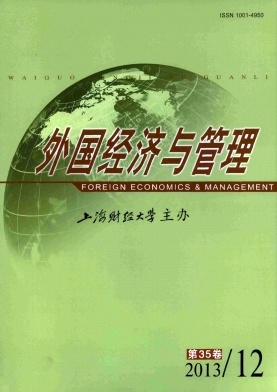新企业成长过程研究述评与展望
外国经济与管理 2013 年 第 35 卷第 12 期, 页码:31 - 40
摘要
参考文献
摘要
近年来,新企业成长过程研究引发了学者们的广泛关注,并取得了大量富有洞见的研究成果。通过文献梳理不难发现,现有研究主要从线性成长、非线性成长和过程机理三个视角研究新企业的成长过程。本文先分别对上述三个视角的新企业成长过程研究进行了述评,然后针对现有研究仍存在的不足,对未来研究进行了展望。
[1]Adizes I.Corporate life cycles:How and why corporations grow and die and what to do about it[M].Englewood Cliffs,NJ:Prentice Hall,1989.
[2]Ambos T and Birkinshaw J M.How do new ventures evolve?An inductive study of archetype changes in science-based ventures[J].Organization Science,2010,21(6):1125-1140.
[3]Andries P and Debackere K.Adaptation in new technology-based ventures:Insights at the company level[J],International Journal of Management Reviews,2006,8(2):91-112
[4]Baker T and Nelson R E.Creating something from nothing:Resource construction through entrepreneurial bricolage[J].Administrative Science Quarterly,2005,50(3):329-366.
[5]BhidéA.The origin and evolution of new businesses[M].Oxford:Oxford University Press,2000.
[6]Churchill N C and Lewis V L.The five stages of small business growth[J].Harvard Business Review,1983,61(3):30-50.
[7]Deakins D and Freel M.Entrepreneurial learning and the growth process in SMEs[J].Learning Organization,1998,5(3):144-155.
[8]Garnsey E.A theory of the early growth of the firm[J].Industry and Corporate Change,1998,7(3):523-556.
[9]Gartner W B.A conceptual framework for describing the phenomenon of new venture creation[J].Academy of Management Review,1985,10(4):696-706.
[10]Gersick C J G.Pacing strategic change:The case of a new venture[J].Academy of Management Journal,1994,37(1):9-45
[11]Gilbert B A,et al.New venture growth:A review and extension[J].Journal of Management,2006,32(6):926-950.
[12]Greiner L E.Evolution and revolution as organization growth[M].Boston:Harvard Business Review,1972.
[13]Kazanjian R K.Relation of dominant problems to stages of growth in technology-based new ventures[J].Academy of Management Journal,1988,31(2):257-279.
[14]Kimberly J R.Issues in the creation of organizations initiation,innovation,and institutionalization[J].Academy of Management Journal,1979,22(3):437-457.
[15]Levie J and Lichtenstein B B.A terminal assessment of stages theory:Introducing a dynamic states approach to entrepreneurship[J].Entrepreneurship Theory and Practice,2010,34(2):317-350.
[16]Phelps R,et al.Life cycles of growing organizations:A review with implications for knowledge and learning[J].International Journal of Management Reviews,2007,9(1),1-30.
[17]Quinn R E and Cameron K.Organizational life cycles and shifting criteria of effectiveness:Some preliminary evidence[J].Management Science,1983,29(1):33-51.
[18]Santos F M and Eisenhardt K M.Constructing markets and shaping boundaries:Entrepreneurial power in nascent fields[J].Academy of Management Journal,2009,52(4):643-671.
[19]Sarasvathy S.Causation and effectuation:Toward a theoretical shift from economic inevitability to entrepreneurial contingency[J].Academy of Management Review,2001,26(2):243-263.
[20]Sarasvathy S and Dew N.New market creation as transformation[J].Journal of Evolutionary Economics,2005,15(5):533-565.
[21]Terpstra D E and Olson P D.Entrepreneurial start-up and growth:A classification of problems[J].Entrepreneurship Theory and Practice,1993,17(3),5-20.
[22]Van de Ven A and Poole M.Explaining development and change in organizations[J].Academy of Management Review,1995,20(3):510-540.
[23]Vohora A,et al.Critical junctures in the development of university high-tech spinout companies[J].Research Policy,2004,33(1):147-175.
[24]王迎军,韩炜.新企业成长过程中商业模式的构建研究[J].科学学与科学技术管理,2011,(9):51-58.
①生命周期理论(life cycle theory)是一种论述组织发展过程的常见理论(参见van de Ven和Poole,1995)。但更广泛地看,生命周期理论是阶段模型的一个子类(Levie和Lichtenstein,2010)。本文认为,“阶段模型”虽然重在反映组织发展过程的阶段性,但不一定要套用诞生、成长、成熟和衰退等生命周期概念。因此,本文使用“阶段模型”一词,能够涵盖那些并没有套用生命周期概念的文献。
②Levie和Lichtenstein认为,他们的研究是针对阶段模型的最完整、最系统的一项文献研究,其文献来源包括期刊文献以及被收入数据库的学术会议论文、专著和商科博士论文。但有意思的是,本文涉及的一些较为知名的新企业成长文献(如Garnsey,1998;Vohora等,2004)并未被他们纳入分析范围。
③Garnsey后来开展了相关的实证研究(参见Garnsey等,2006)。
[2]Ambos T and Birkinshaw J M.How do new ventures evolve?An inductive study of archetype changes in science-based ventures[J].Organization Science,2010,21(6):1125-1140.
[3]Andries P and Debackere K.Adaptation in new technology-based ventures:Insights at the company level[J],International Journal of Management Reviews,2006,8(2):91-112
[4]Baker T and Nelson R E.Creating something from nothing:Resource construction through entrepreneurial bricolage[J].Administrative Science Quarterly,2005,50(3):329-366.
[5]BhidéA.The origin and evolution of new businesses[M].Oxford:Oxford University Press,2000.
[6]Churchill N C and Lewis V L.The five stages of small business growth[J].Harvard Business Review,1983,61(3):30-50.
[7]Deakins D and Freel M.Entrepreneurial learning and the growth process in SMEs[J].Learning Organization,1998,5(3):144-155.
[8]Garnsey E.A theory of the early growth of the firm[J].Industry and Corporate Change,1998,7(3):523-556.
[9]Gartner W B.A conceptual framework for describing the phenomenon of new venture creation[J].Academy of Management Review,1985,10(4):696-706.
[10]Gersick C J G.Pacing strategic change:The case of a new venture[J].Academy of Management Journal,1994,37(1):9-45
[11]Gilbert B A,et al.New venture growth:A review and extension[J].Journal of Management,2006,32(6):926-950.
[12]Greiner L E.Evolution and revolution as organization growth[M].Boston:Harvard Business Review,1972.
[13]Kazanjian R K.Relation of dominant problems to stages of growth in technology-based new ventures[J].Academy of Management Journal,1988,31(2):257-279.
[14]Kimberly J R.Issues in the creation of organizations initiation,innovation,and institutionalization[J].Academy of Management Journal,1979,22(3):437-457.
[15]Levie J and Lichtenstein B B.A terminal assessment of stages theory:Introducing a dynamic states approach to entrepreneurship[J].Entrepreneurship Theory and Practice,2010,34(2):317-350.
[16]Phelps R,et al.Life cycles of growing organizations:A review with implications for knowledge and learning[J].International Journal of Management Reviews,2007,9(1),1-30.
[17]Quinn R E and Cameron K.Organizational life cycles and shifting criteria of effectiveness:Some preliminary evidence[J].Management Science,1983,29(1):33-51.
[18]Santos F M and Eisenhardt K M.Constructing markets and shaping boundaries:Entrepreneurial power in nascent fields[J].Academy of Management Journal,2009,52(4):643-671.
[19]Sarasvathy S.Causation and effectuation:Toward a theoretical shift from economic inevitability to entrepreneurial contingency[J].Academy of Management Review,2001,26(2):243-263.
[20]Sarasvathy S and Dew N.New market creation as transformation[J].Journal of Evolutionary Economics,2005,15(5):533-565.
[21]Terpstra D E and Olson P D.Entrepreneurial start-up and growth:A classification of problems[J].Entrepreneurship Theory and Practice,1993,17(3),5-20.
[22]Van de Ven A and Poole M.Explaining development and change in organizations[J].Academy of Management Review,1995,20(3):510-540.
[23]Vohora A,et al.Critical junctures in the development of university high-tech spinout companies[J].Research Policy,2004,33(1):147-175.
[24]王迎军,韩炜.新企业成长过程中商业模式的构建研究[J].科学学与科学技术管理,2011,(9):51-58.
①生命周期理论(life cycle theory)是一种论述组织发展过程的常见理论(参见van de Ven和Poole,1995)。但更广泛地看,生命周期理论是阶段模型的一个子类(Levie和Lichtenstein,2010)。本文认为,“阶段模型”虽然重在反映组织发展过程的阶段性,但不一定要套用诞生、成长、成熟和衰退等生命周期概念。因此,本文使用“阶段模型”一词,能够涵盖那些并没有套用生命周期概念的文献。
②Levie和Lichtenstein认为,他们的研究是针对阶段模型的最完整、最系统的一项文献研究,其文献来源包括期刊文献以及被收入数据库的学术会议论文、专著和商科博士论文。但有意思的是,本文涉及的一些较为知名的新企业成长文献(如Garnsey,1998;Vohora等,2004)并未被他们纳入分析范围。
③Garnsey后来开展了相关的实证研究(参见Garnsey等,2006)。
引用本文
张敬伟. 新企业成长过程研究述评与展望[J]. 外国经济与管理, 2013, 35(12): 31–40.
导出参考文献,格式为:
下一篇:西方钱包份额研究述评





 6691
6691  550
550

